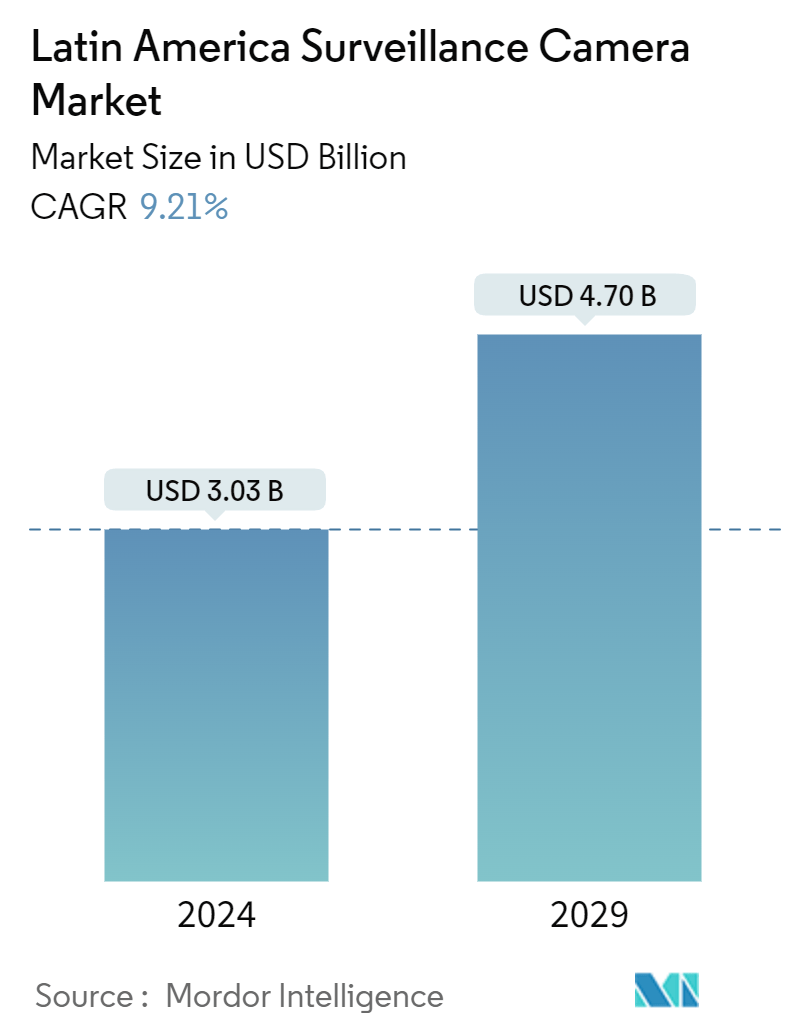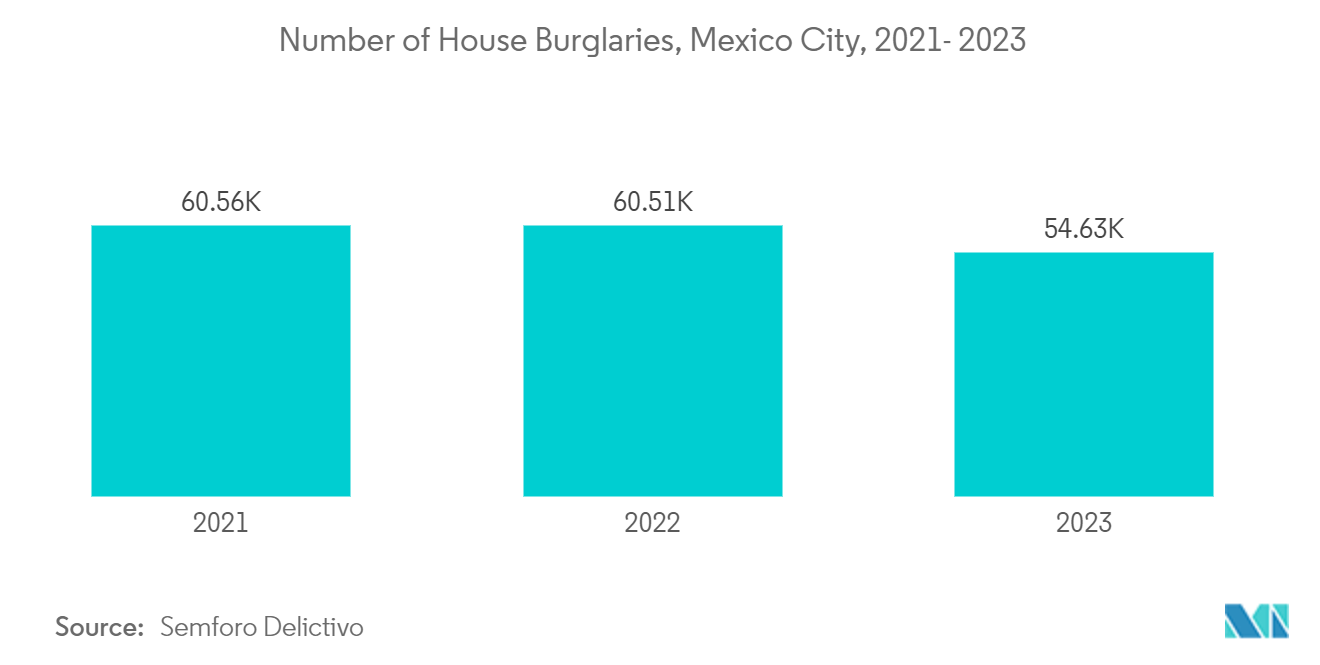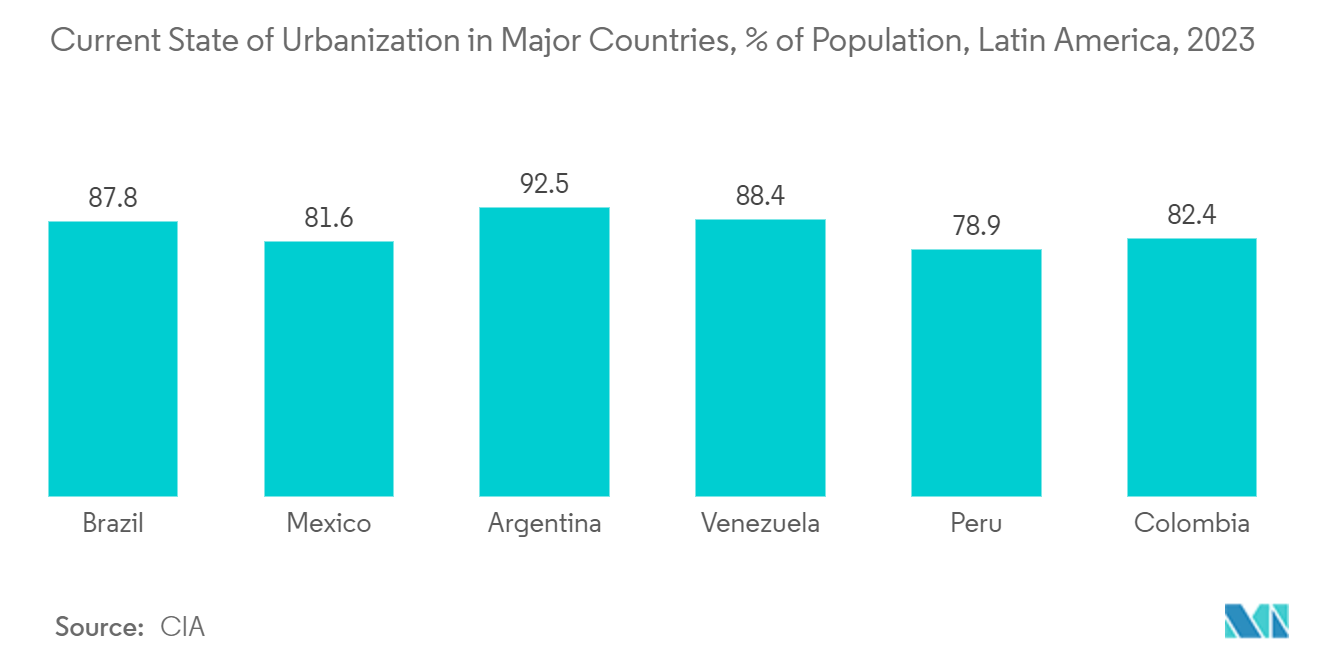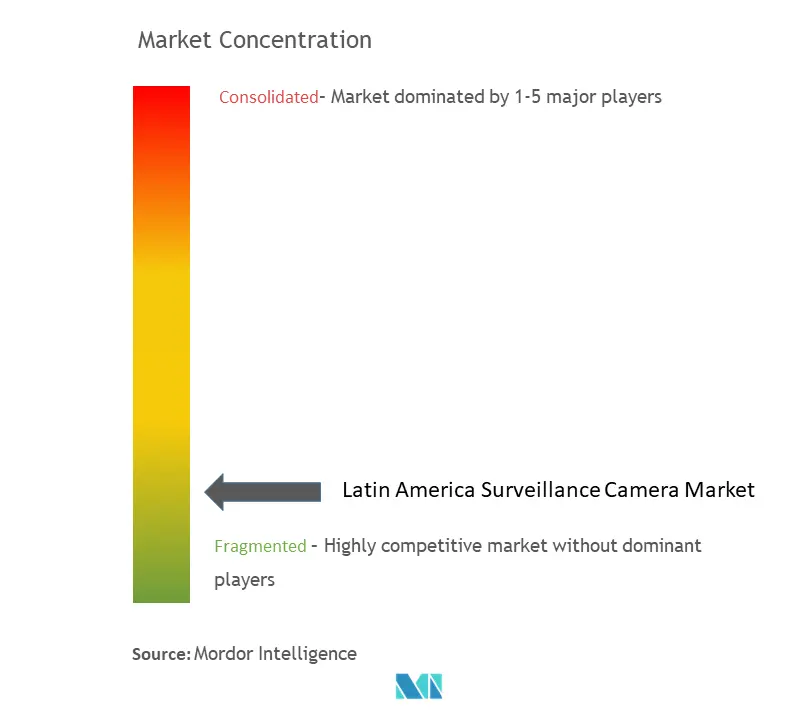Latin America Surveillance Camera Market Size

| Study Period | 2019 - 2029 |
| Base Year For Estimation | 2023 |
| Market Size (2024) | USD 3.03 Billion |
| Market Size (2029) | USD 4.70 Billion |
| CAGR (2024 - 2029) | 9.21 % |
| Market Concentration | Low |
Major Players
*Disclaimer: Major Players sorted in no particular order |
Latin America Surveillance Camera Market Analysis
The Latin America Surveillance Camera Market size is estimated at USD 3.03 billion in 2024, and is expected to reach USD 4.70 billion by 2029, growing at a CAGR of 9.21% during the forecast period (2024-2029).
Surveillance cameras have experienced a rapid expansion, incorporating and adapting to new trends and technologies, such as machine learning, night vision, infrared, thermal imaging, video analytics, AI (artificial intelligence), and IoT (Internet of Things), to provide end users with comprehensive security solutions. Not only are surveillance cameras cost-effective, but they are also simple to set up and maintain. Furthermore, they have a high degree of scalability, allowing them to be upgraded or downgraded at any time.
In Latin America, the demand for surveillance cameras is rising due to several factors, including growing urbanization, increasing awareness of the necessity of security measures, and increasing criminal activity. For instance, according to InSight, a crime organization, in 2023, Jamaica was the leading country in terms of the number of homicides recorded in Latin America and the Caribbean, followed by Ecuador, Haiti, Trinidad and Tobago, Honduras, and Venezuela, among others.
Furthermore, the recent innovations in the technological capabilities of surveillance cameras also encourage people to adopt them to enhance the safety quotient of their premises. For instance, facial recognition technology has further advanced the capabilities of surveillance cameras, enabling them to identify and monitor individuals more effectively.
Surveillance technology is on the rise in Latin America, particularly in Mexico. Over the last decade, Mexico has implemented the largest video surveillance system in the Americas, significantly impacting criminal investigations. One presidential candidate aims to enhance the system by incorporating additional biometrics. For the past two decades, the city's administrations have prioritized video surveillance as a key tool in combating the surge in violent crime, largely attributed to the drug war. The last five years have witnessed a sharp uptick in the deployment of surveillance cameras. Presently, Mexico boasts a network of over 64,000 cameras, with plans to surpass 80,000 by the close of 2024.
In Argentina, the installation of surveillance cameras has grown significantly in recent years. The Comprehensive Video Surveillance Plan (CVSP) of the Argentine government (Ministry of Justice and Security) of Buenos Aires (the City of Buenos Aires) commits to monitoring 75% of city video surveillance. Implementing the CVSP was possible due to the incorporation of surveillance cameras, as the government believes surveillance cameras are essential for preventing criminal activity and promptly resolving illegal activity.
The emergence of the IoT has enabled surveillance cameras to be integrated with other smart devices, creating a comprehensive and interconnected security infrastructure. This integration allows users to monitor the cameras remotely, receive real-time alerts, and integrate with other smart home and business automation systems to provide comprehensive security data automatically to local law enforcement and safety alerts to residents via mobile phones.
In recent years, there has been an increased awareness of the potential for privacy and the ethical implications of extensive surveillance. While these technologies have been demonstrated to be beneficial in improving public security, there are still concerns about the privacy and ethical implications. For instance, in July of 2023, Sao Paulo announced the implementation of thousands of facial recognition surveillance cameras in the Brazilian metropolis. However, authorities are concerned that this technology's indiscriminate application could exacerbate structural racism and inequalities, as well as potential risks to data security and cybersecurity.
Furthermore, the higher cost of advanced surveillance cameras, the lack of skilled workers to operate IP cameras, and lower awareness across several countries continue to challenge the surveillance camera market's growth in Latin America.
Latin America Surveillance Camera Market Trends
IP-based Camera Gaining Popularity
- The demand for internet protocol (IP)-based camera systems is on the rise, driven by the continuous evolution of infrared cameras and the integration of IoT in video surveillance. As incidents of burglaries and home invasions escalate, residential security has become a paramount concern for homeowners.
- Statistics from Semáforo Delictivo revealed that Mexico witnessed 54,632 private home burglaries in 2023, a decrease from the 60,514 incidents reported the previous year. While 2017 marked a peak in house burglaries, the numbers have been steadily declining since. Additionally, the Brazilian Public Safety Annual Report 2023 highlighted a worsening public safety landscape. In 2022, Brazil recorded 373,225 vehicle thefts, an 8% increase from the previous year. The report also notes a 16% rise in cell phone thefts, reaching one million in 2022. These figures, coupled with a burgeoning smartphone user base and the availability of secure installment subscriptions, underscore a promising trajectory for the residential security market.
- As digital camera technologies advance, the prominence of cloud-based solutions is bolstering the role of IP-based cameras in Latin America. Many firms are channeling significant investments into cloud technologies, marking a new era in surveillance. The advent of cloud-based cameras has spurred companies to introduce direct-to-cloud VMS, empowering users to manage their systems remotely from any device.
- In June 2024, Verkada unveiled its '2024 State of Cloud Physical Security' report, drawing insights from IT and physical security leaders. The report delves into prevailing trends, industry challenges, and the shift from on-premises to cloud-based setups. Notably, the report highlights that over 90% of security leaders foresee the future of physical security hinging on cloud solutions. These solutions promise enhanced scalability, real-time alerts, and AI integration, painting a bullish outlook for IP-based surveillance cameras in the regional market.

Brazil to Witness Significant Growth
- Brazil's urbanization has resulted in a higher population density in cities. According to the Central Intelligence Agency (CIA), in 2023, about 87.8% of the population in Brazil was living in urban areas. The CIA also predicts a 0.87% change in the urbanization rate during 2020-2025. Such trends necessitate the implementation of surveillance cameras to monitor public places, residential areas, and streets to ensure residents' safety.
- Brazil is also among the leading countries in Latin America, which is witnessing the fastest growth in economic and infrastructure development, owing to which the demand for surveillance cameras continues to rise to secure crucial infrastructure. For instance, Sao Paulo and Mato Grosso are among Brazil's leading regions with the highest concentration of private airports. Genetec provided security and leisure services from the curb to the gate at Brazil's Floripa International Airport since 2023. Genetec's platform manages over 500 surveillance cameras and 210 doors to the terminal's administrative, critical areas, including boarding, arrivals, and customs.
- Several recent initiatives by public authorities also support the market's growth in Brazil. For instance, advanced surveillance solutions like facial recognition technologies are being used at Brazilian metro stations. Solutions provided by Intelligent Security Systems (ISS) were recently equipped at Line 3-Red of the Sao Paulo Metro, including face biometrics technology and object identification and tracking capabilities.
- Educational institutions can safeguard resources, equipment, and buildings from theft and vandalism by implementing surveillance cameras in high-security areas. Axis Communications, specializing in video surveillance solutions, has successfully transitioned several institutions from an analog surveillance system to an IP/PoE solution. Furthermore, the company has also been working with several corporate vendors in Brazil. For instance, in 2023, Vivo, a leading consumer electronics company with hundreds of stores in Brazil, adopted surveillance systems as a pilot project in its 80 stores and planned to extend it to over 100 stores. According to Vivo, the surveillance solution consisted of AXIS M30 Dome series cameras.
- Furthermore, in recent years, vehicle theft and car breakage incidents have also increased in Brazil, which is anticipated to drive the adoption of surveillance cameras in parking lots and cars. The potential for video analytics to identify, assess, and act upon unusual or suspicious activity can increase the demand for video analytics systems in areas susceptible to vehicle break-ins.

Latin America Surveillance Camera Industry Overview
The Latin American surveillance camera market is becoming competitive, as the growing demand for surveillance cameras is driving more players to the market, which is also shifting the market's landscape toward a fragmented market. Partnerships, collaborations, new product launches, high expense on research and development, and mergers and acquisitions are the major growth strategies adopted by several regional companies to sustain this intense competition. Key players in the market include i-PRO, Verkada Inc., The Infinova Group, Genetec Inc., and Teledyne FLIR LLC.
- In February 2024, about 20 security cameras were installed in Cozumel City, Mexico. The cameras are equipped with facial recognition analytical technology to allow the city authorities to react immediately to any eventuality.
- In September 2023, Gorilla Technology Group Inc., a leading provider of AI-driven edge video analytics, security convergence, and IoT solutions, entered a strategic partnership with Protactics, a Colombian enterprise specializing in comprehensive security and defense technology solutions. This collaboration aimed to enhance Gorilla Technology's market presence in Latin America.
Latin America Surveillance Camera Market Leaders
-
i-PRO
-
Verkada Inc.
-
The Infinova Group
-
Genetec Inc
-
Teledyne FLIR LLC
*Disclaimer: Major Players sorted in no particular order

Latin America Surveillance Camera Market News
- August 2023 - Verkada Inc., a cloud-managed security and management platform for enterprise building security, launched CP52E PTZ (pan-tilt-zoom camera). This camera, in combination with the company's existing product offerings and platform integrations, is expected to enable Verkada to provide customers with even more value. The CP52E CPZ camera is designed to provide users with the ability to observe large areas with ease. It is engineered to have a low latency (less than 500 ms) and is equipped with 28x optical zoom, providing users with a high level of detail in even the most challenging lighting conditions with an IR range of 100 m/ 382 ft.
- August 2023 - Axis Communications, a global leader in network cameras and access control, announced the onboarding of AlJammaz Technologies as its latest distribution partner in Saudi Arabia. This strategic partnership aims to expand Axis's market presence in Saudi Arabia, facilitating further investment in the region. Saudi Arabia's commitment to innovation, as demonstrated by Vision 2030, aligns with Axis's strategic objectives. By collaborating with AlJammaz Technologies, known for its expertise in value-added distribution and channel network development, Axis is well-positioned to address the increasing demand for advanced security solutions in the Saudi Arabian market.
Latin America Surveillance Camera Market Report - Table of Contents
1. INTRODUCTION
- 1.1 Study Assumptions and Market Definition
- 1.2 Scope of the Study
2. RESEARCH METHODOLOGY
3. EXECUTIVE SUMMARY
4. MARKET INSIGHTS
- 4.1 Market Overview
-
4.2 Industry Attractiveness - Porter's Five Forces Analysis
- 4.2.1 Bargaining Power of Suppliers
- 4.2.2 Bargaining Power of Consumers
- 4.2.3 Threat of New Entrants
- 4.2.4 Threat of Substitutes
- 4.2.5 Intensity of Competitive Rivalry
- 4.3 Impact of Macroeconomic Factors on the Market
5. MARKET DYNAMICS
-
5.1 Market Drivers
- 5.1.1 Increasing Government Efforts to Enhance Public Safety
- 5.1.2 High Crime Rates and Security Issues
-
5.2 Market Challenges
- 5.2.1 Increasing Prevalence of Security Breaches
- 5.2.2 Legal Frameworks Governing Surveillance and the Data Collection
6. MARKET SEGMENTATION
-
6.1 By Type
- 6.1.1 Analog-based
- 6.1.2 IP-based
- 6.1.3 Hybrid
-
6.2 By End-user Industry
- 6.2.1 Government
- 6.2.2 Banking
- 6.2.3 Healthcare
- 6.2.4 Transportation and Logistics
- 6.2.5 Industrial
- 6.2.6 Other End-user Industries (Education Institutions, Retail, and Enterprises)
-
6.3 By Country***
- 6.3.1 Brazil
- 6.3.2 Mexico
7. COMPETITIVE LANDSCAPE
-
7.1 Company Profiles
- 7.1.1 i-PRO
- 7.1.2 Verkada Inc.
- 7.1.3 The Infinova Group
- 7.1.4 Genetec Inc.
- 7.1.5 Teledyne FLIR LLC
- 7.1.6 Securitas AB
- 7.1.7 Hangzhou Hikvision Digital Technology Co. Ltd
- 7.1.8 Bosch Security Systems GmbH
- 7.1.9 Honeywell International Inc.
- 7.1.10 Dahua Technology Co. Ltd
- 7.1.11 Milestone Systems
- 7.1.12 Axis Communications AB
- 7.1.13 Anviz Global Inc
- 7.1.14 Hanwha Vision Co. Ltd
- 7.1.15 ABB Ltd
- 7.1.16 Eagle Eye Networks
- *List Not Exhaustive
8. INVESTMENT ANALYSIS
9. FUTURE OF THE MARKET
** Subject To AvailablityLatin America Surveillance Camera Industry Segmentation
Surveillance cameras are gaining popularity for their cost-effectiveness and user-friendly nature. This surge has seen a rise in installations across residential and commercial spaces, all aimed at enhancing security. Thanks to technological advancements, these cameras are reshaping the security landscape. They come in a variety of styles and resolutions, tailored for different needs, including indoor, outdoor, box, dome, bullet, IP, day and night, wireless, thermal imaging, PTZ, and beyond. The market is defined by the revenue accrued from the sales of different types of surveillance cameras over various end users across Latin America.
The Latin American surveillance camera market is segmented by type (analog-based, IP-based, and hybrid), end-user industry (government, banking, healthcare, transportation and logistics, industrial, and other end-user industries [educational institutions, retail, and enterprise]), and country (Brazil, Mexico, and Rest of Latin America). The market sizes and forecasts are provided in terms of value (USD) for all the above segments.
| By Type | Analog-based |
| IP-based | |
| Hybrid | |
| By End-user Industry | Government |
| Banking | |
| Healthcare | |
| Transportation and Logistics | |
| Industrial | |
| Other End-user Industries (Education Institutions, Retail, and Enterprises) | |
| By Country*** | Brazil |
| Mexico |
Latin America Surveillance Camera Market Research FAQs
How big is the Latin America Surveillance Camera Market?
The Latin America Surveillance Camera Market size is expected to reach USD 3.03 billion in 2024 and grow at a CAGR of 9.21% to reach USD 4.70 billion by 2029.
What is the current Latin America Surveillance Camera Market size?
In 2024, the Latin America Surveillance Camera Market size is expected to reach USD 3.03 billion.
Who are the key players in Latin America Surveillance Camera Market?
i-PRO, Verkada Inc., The Infinova Group, Genetec Inc and Teledyne FLIR LLC are the major companies operating in the Latin America Surveillance Camera Market.
What years does this Latin America Surveillance Camera Market cover, and what was the market size in 2023?
In 2023, the Latin America Surveillance Camera Market size was estimated at USD 2.75 billion. The report covers the Latin America Surveillance Camera Market historical market size for years: 2019, 2020, 2021, 2022 and 2023. The report also forecasts the Latin America Surveillance Camera Market size for years: 2024, 2025, 2026, 2027, 2028 and 2029.
Latin America Surveillance Camera Industry Report
Statistics for the 2024 Latin America Surveillance Camera market share, size and revenue growth rate, created by Mordor Intelligence™ Industry Reports. Latin America Surveillance Camera analysis includes a market forecast outlook for 2024 to 2029 and historical overview. Get a sample of this industry analysis as a free report PDF download.



